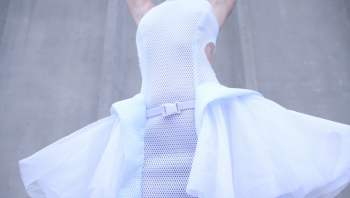
A new evolution of the early Spider Dress smart wearable concept
The concept of a mechanical, 3D printed smart dress, to safeguard one’s proximity and personal space, was first explored by Anouk Wipprecht several years ago with her Spider Dress. In times of social distancing, the Dutch designers is presenting an evolution of that early work, extending her research into proxemics and the body. The new Proximity Dress creates physical barriers when a person is detected in the immediate surroundings of the wearer.
These twin dresses respond based on proximity and thermal sensors and indicate strangers within the intimate, personal, social and public space around the wearer. Each dress extends itself using a robotic 3D printed hip mechanism, built into the dress, and a resin 3D printed transparent collar with integrated sensors. The dress also works as a perfect application case study for 3D printing. The hip mechanisms that are holding the servos to the mechanic hip parts are 3D printed using SLS (Selective Laser Sintering) nylon PA-11 to endure more stresses. The 3D printed transparent collar, which has a more aesthetic use, is 3D printed using an Objet Connex 500 multimaterial polyjet 3D printer and the VeroClear material from Stratasys.
“I haven’t made dresses for myself in a long time,” Anouk posted, “and I got a bit fed up with people in public not considering the current distancing suggestions, so this one I’m keeping…”
“As with my earlier robotic Spider Dress and Smoke Dress,” she went on, “my designs are based on the Proxemics Theory of Edward T. Hall. This defines four spaces around the body, each with their own characteristic distances. Whereas Hall had to measure the space between people using a wooden stick, I have been working since 2007 to translate these concepts into the digital domain, in order to measure the spaces between people up to a range of 25 feet.”
The sensors provide virtually noise-free distance readings through the use of high-output acoustic power combined with continuously variable gain, real-time background automatic calibration, real-time waveform signature analysis, and noise rejection algorithms. This holds true even in the presence of various acoustic or electrical noise sources, making it suitable for on-body use.
Using such sensors allows the dresses to trace the world around them invisibly, and do not threaten privacy, as they do not record any video imagery: the people around the wearer remain anonymous.
Photo
Shot by Jeff Cacossa || Anouk Wipprecht
Shot on Lumix GH5 || with Metabones Speedbooster || Sigma Art lens 18-35mm
Track: ‘Robot’ by DavidYAN
* The Proximity Dress 2.0 is based on Anouk Wipprecht’s 2012 prototype of this dress using hip mechanics create distance and a proximity sensor (ultrasonic rangefinder) for VW showcase during IAA, in Germany.
PROJECT PROXIMITY 'Proximity Dress' - Robotic Personal Space Defender Series || Anouk Wipprecht from Anouk Wipprecht on Vimeo.


